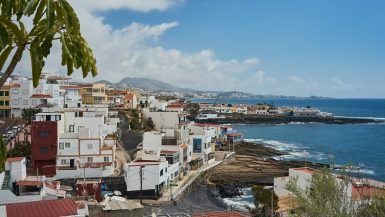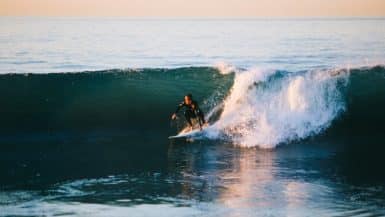
Ready the goggles and the flippers, folks, we’re going a-hunting for the best snorkeling in Spain. Yep, this guide aims to case out the salt-washed coastline of the land of paella and flamenco, to offer such fantastic underwater marine safaris that you won’t even want to paddle back in for your siesta and sangria.
It’s mainly focused on the southern shores of the country, around the Spanish Mediterranean. That’s because it’s where the waters are calmer and more protected from big swells, which can ruin snorkeling. So, expect plenty of options on the sides of the Balearics and up the rocky Costa Brava north of Barcelona.
But we’ve also got a mention of the Canary Islands, where you can get some great family-friendly snorkeling, along with more lived-in parts of the coast down in Murcia. Whichever you pick, here’s to hoping you encounter those Spanish octopi and sea turtles this holiday!
Medes Islands – probably the best snorkeling in Spain overall!

The Medes Islands host probably the most famous and best snorkeling in Spain. Technically a part of the Costa Brava (more on that later), they fragment off the Mediterranean coast just opposite the town of L’Estartit not far south from the French border.
The reason it’s so darn good up here for bubble-blowing fish seekers is that the shores are predominantly rocky and there’s hardly any sand on the ocean floor, keeping visibility high. On top of that, the whole area of the Med around the Medes Islands has been protected from fishing fleets for something like three decades. Just imagine how much that’s helped the marine life!
In fact, the Medes are considered so important for the local ecosystems that even scuba expeditions are monitored here. It’s likely that you’ll need to apply for a permit to get over and dive in. If you do manage it, then get ready to encounter all sorts of animal life as you hop from the coves of Meda Gran (the largest island) to little Meda Xica and the smaller specks of rock around Carall.
Playa Chica, Lanzarote

Playa Chica Beach is really accessible. It sits just on the edge of the popular resort town of Puerto del Carmen on the south-east coast of Lanzarote. It’s possible to stroll there from the main promenade and most of the hotels in the resort. So, this one doesn’t require some mega snorkeling expedition a la the Medes Islands. It’s more of an every-person’s snorkeling spot.
Two fingers of Lanzarote’s trademark volcanic rock protect the bay to the north and south. They help to keep out the dominant NW swells that roll into this half of the island, stilling the water and rendering it calm enough for watching fish. They also help to make this some of the best snorkeling in Spain for families, since it’s easy to keep an eye on the little ones as they bob around the bay in search of anemones and whatnot.
What’s really great about snorkeling in Lanzarote is just how warm the H2O is. The sea manages to maintain a pretty steady 74-76 degrees in temperature throughout the whole year. On top of that, the skies are almost always clear while the sun is almost always beating down in the Canaries, so you can top up the tan in between those water sports sessions.
The Costa Brava

We include the whole of the Costa Brava here because it really is a snorkeling mecca from start to finish. It’s one of the least known and least built-up of the shorelines along the Spanish Mediterranean. That’s largely down to the fact that it doesn’t have the same long, uninterrupted sand stretches as, say, the Costa del Sol. It’s more rugged, rockier, and made up of pebbly coves.
All that should be music to the ears of would-be snorkelers. Why? Well…Rocky shorelines rank much higher when it comes to visibility than their sandy compadres. They can also host a real kaleidoscope of marine life, offering nooks and crannies for seagrasses and all sorts of multi-colored fish to call their home.
That’s exactly what you get on the Costa Brava. And you get a whopping 125 miles of it at that. The northernmost part of the region right by the France-Spain border is definitely the best for snorkelers. It hosts the craggy Cap de Creus Natural Park. There, narrow inlets that mimic the calanques of Marseille are riddled with anemones and starfish and octopi.
The other good news is that the snorkeling on the Costa Brava isn’t only in the far-flung parts of the coastline. The waters in the more developed areas of the region still retain good visibility. That means great underwater viewing in spots like Platja d’Aro, Sant Feliu de Guíxols, and even the party town of Lloret de Mar.
Cala Mitjana, Menorca

Cala Mitjana is just one of several stunning inlets on the south shore of Menorca. It runs below a rocky stretch of chalk-white limestone cliffs on one of the least built-up parts of the island. That means there’s not much to interrupt the marine life, save for the odd millionaire yacht that drifts in and out of the bay each morning.
Cala Mitjana itself is fronted by a small dash of pebbly sand where you can drop your stuff. The snorkeling is really easy to access, as the inlet gets nice and deep only a stone’s throw from the beachfront. The best places to paddle out are to the west or east of the cove. Both sides are dominated by craggy runs of rock that have been whittled away by the movement of the Med over the centuries. They’re now beset by small caves and grottoes and boulders where everything from rock fish to weevers to darting espets can be witnessed.
What’s great about a snorkeling day out at Cala Mitjana is that’s it’s not just about what animals you can find under the sea. It’s also a good excuse to explore one of the most glorious runs of coast in the Balearics. You can hike the pine-studded trails behind to find other beaches like Cala de Trebalúger and Cala Macarella. The nearby town of Cala Galdana is also a lovely place to stop for lunch if you have the time.
Calo des Moro, Mallorca

It’s hard to resist the glass-transparent waters of Calo des Moro, no matter if you’ve bought the snorkels with you or not. This is one of Mallorca’s most incredible beaches, which is saying something because there are loads on offer on the island. It makes its home just south of little Cala Llombards on the south-eastern end of the island, one of many narrow inlets that pierce into the cliffs there.
What sets this inlet apart from all the others is that it’s just a touch longer. It runs for almost 100 meters before it joins the open Mediterranean. More than that, it sort of doglegs inland, bending into the final bay at its base after wiggling around high cliffs topped by tufts of stone pines. The result? There are plenty of places to venture to once you’ve fixed the goggles and pulled on the bubble pipe, and the H2O tends to be quite still.
We’d pay special attention to the north flank of the Calo des Moro headland. That’s carved by one big opening in the rock that’s often a favorite hangout for scorpionfish, although it’s more commonly filled with smaller darting fish, sardines, and seahorses. Only the strongest swimmers should venture beyond the turn in the cliffs. That’s where the water gets a little rougher and you’re more likely to see larger species like groupers.
Cape Palos

Cape Palos might be best known for the hard-fought Battle of Cape Palos, which was the largest naval battle in the whole of the Spanish Civil War. That was actually the last of the Republican victories in the brutal conflict, and ultimately did nothing to derail the rise of Fascist Spain under Franco. Anyway…where were we? Ah, yep: Cape Palos; a battleground but also home to some of the best snorkeling in Spain…
Pull on the goggles here and you’ll be able to dive into a true underwater wonderworld. Forged from volcanic rock thousands of years ago, the headland pokes out westwards into the Mediterranean to steer clear of prevailing swells and offer all sorts of hidden crevices where fish thrive and animals reside.
The northern side of the peninsula is the best place to snorkel. It’s got way more protection from the westerly swells that can come through the sea from the open Atlantic Ocean via the Gibraltar Strait. That means stiller aqua and more chances to spot fish without plumes of upturned silt and sand. Head to Cala Tunisia at the end of the cape to find a more remote spot that gets to up to 12 meters deep only a few strokes out. That’s probably the best of the lot.
Cabrera Island

Check the map – that speck (or specks) on the map south of Mallorca is Cabrera Island and its next-door neighbors. Together they form a whole national marine park, marking a totally uninhabited place that was once given over to the Spanish government as a naval military base. These days, it’s a popular day-trip destination from the more mainstream Balearics, not to mention home to some of the best snorkeling in Spain.
Choose a tour that includes snorkeling stops at the Posidonia oceanica prairies and the Blue Cave. The first is a stretch of submerged Neptune grass that’s a favorite habitat for loggerhead turtles, conger eels, and bigger fish species like groupers. The latter is a colossal gaping cleft in the coast of the island where sunlight refracts through a small opening to sparkle in dazzling hues of turquoise within a central cavern. Diving straight off the side of the boat inside is a truly unique snorkeling experience.
Anchoring on Cabrera Island is actually prohibited, but you’ll want to survey the rugged peaks and troughs of the landscapes there as you sail. One summit is even crowned by an impressive castle that dates from the 1300s. But don’t take your eyes off the water for too long – it’s possible to glimpse dolphins, fin whales, and even orcas here on occasion.
So, where’s the best snorkeling in Spain?
The Medes Islands are generally hailed as the best snorkeling in Spain overall. They occupy a very rocky corner of the coast that’s well protected from big ocean swells that come from the west. Fishing has been banned in their waters for decades, too, so there’s loads of species to see. That said, you can find amazing snorkeling locations all over the Balearic Islands and in the Canaries, along with plenty more down the shores of the Spanish Mediterranean.


